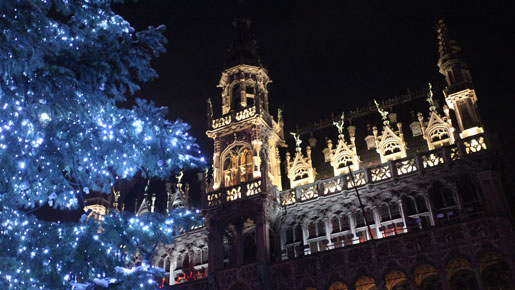
Although respected for its role in international politics and business, Brussels is also ridiculed for its bureaucracy. People say that it is a dull place, the life sucked out of the city by the thousands of civil servants who make it their home.
Fortunately visitors to Brussels, this is neither fair nor true. The city is a vibrant place with a thriving restaurant and bar culture, plenty of diverting museums and galleries, enticing shopping opportunities and gorgeous art nouveau architecture. Anyone saying Brussels is boring clearly hasn’t been there.
The city’s history stretches back around 1,500 years to when Saint Gaugericus, the bishop of Cambrai, established a chapel on the site in the sixth or seventh century. Over the next several hundred years the settlement flourished, eventually becoming an important centre for trade in the region, home to many skilled craftsmen. Brussels has changed hands many times, ruled by the French, the Flemish and the Hapsburgs, before Belgium finally declared independence in 1830. The city’s more recent history has unfortunately been dominated by the destruction of the World Wars, but also by the extraordinary cultural blossoming of the last 100 years.
The result is a metropolis rich in history, where Gothic masterpieces, such as the imposing Cathédrale Saints-Michel-et-Gudule (on the UNESCO-listed Grand Place, at the city’s heart) exist alongside striking modern monuments such as the Atomium, which was built for the 1958 Brussels World Fair.
To get a sense of this history and cultural diversity, the city’s highly acclaimed museums are a must – and with more than 80 to choose from, including the Royal Museums of Fine Arts of Belgium, with its collection of over 20,000 works dating from the early 15th-century (fine-arts-museum.be), and the fascinating, interactive Musical Instruments Museum (mim.be) – visitors will find enough to occupy them on many a return trip.
But before even setting foot inside these impressive institutions, one is struck by the living art that pervades the city. Large-scale graffiti murals adorn the walls of Brussels, enlivening the panorama and offering surprises around every corner. From the huge Tintin mural on Rue de L’Etuve – just a short walk from the famous Mannekin Pis statue and the Grand Place – to the enormous fish skeleton daubed high above the Place Louise, Brussels is jam-packed with street art.
And then there’s the stunning art nouveau architecture, a city-wide collection to rival the glories of Gaudí’s Barcelona. Ghent-born architect Victor Horta, widely acknowledged as one of the founding fathers of modern European architecture, lived in Brussels from 1880 until his death in 1947 (bar a period living in London and the United States between 1915 and 1919) and revolutionised the city’s architecture, eschewing the styles of the past and bringing art to everyday life.
You can spot some of Horta’s most remarkable buildings, including his house and studio, now the site of the Horta Museum, in the Saint-Gilles/Ixelles area of the city. Don’t miss the Hôtel Tassel at 6 Rue Paul-Emile Janson, considered by many as the first true example of an art nouveau building, the Maison Matyn at 50 Rue de Bordeaux and the Hôtel Solvay at 224 Avenue Louise. The Horta Museum, at 25 Rue Américaine (0032 (0)2 543 04 90; hortamuseum.be), is essential viewing for anyone interested in the architect himself as well as his architectural style.
He built the house in 1898 and lived and worked there until 1919. It became a museum in 1969 and is a uniquely beautiful place to explore.
Culture is all well and good, of course, but without sustenance, there is only so much that a visitor can take in. So while in the area, consider stopping for a beer at one of the fine local bars, most of which offer an excellent selection of beers. Supra Bailly (77 Rue de Bailli; 0032 (0)2 534 09 01) has a fantastic, informal atmosphere that will make you feel like one of the regulars.
Belgium is justifiably proud of its cuisine, which is characterised by strong flavours and unpretentious dishes including the omnipresent moules-frites, waffles and, of course, gourmet chocolate. Chocolate shops can be found throughout the city, whether you are looking for internationally known brands such as Leonidas and Godiva or small-scale independent operations such as Zaabär (125 Chaussée de Charleroi; 0032 (0)2 533 95 80; zaabar.be), which specialises in unusual flavours including sage, lavender and rose hip.
Anyone exploring the centre of touristic Brussels will find themselves with an enormous range of dining options – the pedestrianised Rue des Bouchers is an extraordinary alley of restaurants, their tables and displays of fresh seafood spilling out onto the street, narrowing the already slender walkway. With so many eateries it is easy to go wrong here, but Chez Leon (18 Rue des Bouchers; 0032 (0)2 511 14 15; uk.chezleon.be), a sprawling ‘temple of mussels and chips’ established in 1893, will not disappoint.
For an even more atmospheric dining experience, away from the centre of town, Stekerlapatte (4 Rue des Prêtres; 0032 (0)2 512 86 81; stekerlapatte.be) is a local favourite. It serves rustic Belgian specialities including grilled pig’s trotter, rabbit in gueuze (a sour local beer) and caramelised spare ribs.
Brussels is also a strong contender when it comes to performance, with a lively music and theatre scene. Most seasons of work begin in September, including that at the Theatre La Monnaie de Munt, which is hosting Yvonne, Princess de Bourgogne, a new opera by Belgian composer Philippe Boesmans, and Creation 2010, dance by prominent contemporary choreographer Anne Teresa De Keersmaeker (new.lamonnaie.be). Meanwhile at Flagey, a multi-arts centre located in a striking art deco building, the Brussels Philharmonic will be playing a programme of Mahler, Debussy and Ravel as part of the KlaraFestival 2010 (flagey.be).
They say that only boring people get bored. Not in Brussels they don’t.

